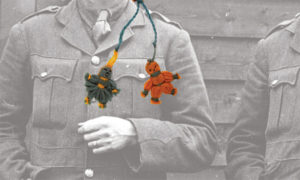The charm of these WWI tokens endures.
December 2018 | view this story as a .pdf
By Rhea Côté Robbins
 In my search for the vestiges of my Franco-American culture, once lost to me, something else was recently revealed. Initially, I was looking for milagro—miracles in Spanish—charms for good luck or protection. What I happened upon instead was an international site of good luck charms. Listed among them were two yarn figures from France, designed to be clipped to the uniform pockets of World War I soldiers to protect them from falling bombs—invoking the spirits of the gods on whoever dared or chose to believe. Looking for malagros, I stumbled upon the porte-bonheur poupées Nénette and Rintintin.
In my search for the vestiges of my Franco-American culture, once lost to me, something else was recently revealed. Initially, I was looking for milagro—miracles in Spanish—charms for good luck or protection. What I happened upon instead was an international site of good luck charms. Listed among them were two yarn figures from France, designed to be clipped to the uniform pockets of World War I soldiers to protect them from falling bombs—invoking the spirits of the gods on whoever dared or chose to believe. Looking for malagros, I stumbled upon the porte-bonheur poupées Nénette and Rintintin.
As legend goes, a pair of lovers survived the bombing of Paris by the new German weapon which became known as the Pariskanone, or Paris gun. It could fire a shell into the air from 81 miles away—the stuff of nightmares for a doughboy, plenty of whom came to Europe from our neck of the woods.
This year marks the 100th anniversary of the good luck pair that was crafted by children in Paris and handed to U.S. soldiers to protect them from the bombs—a comfort for many. Thirty-five thousand, two hundred and fourteen men and women from Maine served in the Great War. “Unfortunately, we don’t have an exact number for how many of those individuals served in France during the war,” Maine National Guard Command Historian Jonathan Bratten says. “From my research, I think that it is safe to say that over 10,000 Mainers served in France.”
I don’t question the power of the dolls, given my own belief in superstitions passed down through the generations in the Franco-American or Acadian culture. Interviews in Caribou of French-heritage women conducted in 1972 by future Senator Susan Collins captured some of these. For example, one could dip a spruce branch in water and place it in a window to prevent lightning strikes. A website affiliated with the Acadian Archives at University of Maine at Fort Kent hosts a page celebrating oral traditions of the culture that consider the power of the supernatural in ordinary lives. All this sounds quite normal to me. Why not a couple of yarn dolls to keep the world from raining down on you?
The 1920s movie star dog Rin Tin Tin, who was reputed to have saved Warner Bros. Studios during the Depression, inherited his name from the sweet dolls. Trainer Leland Duncan joined the Army in 1917 and was assigned to the 135th Aero Squadron as a gunnery corporal. Ducking for shelter during bombings along the French front, he discovered an abandoned litter of German Shepherd puppies and their mother. Duncan adopted the brood and took two puppies home with him—a male and a female—at the end of his tour. He called them Nénette and Rin Tin Tin.
In 1998, a survey in Lincoln, Maine, was conducted to select names for a few wooded dirt roads along Cambolasse Pond. Knowing it was a favorite trail for three local golden retrievers, neighbors decided to name the roads accordingly. Perhaps someday luck will have it that you find yourself there—on Benjie Lane, Hoover Lane, or Rin Tin Tin Road.





0 Comments